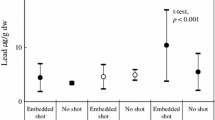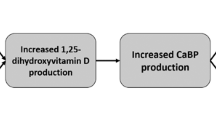Abstract
One-day old American Kestrel (Falco sparverius) nestlings were dosed orally daily with 5 μl/g of corn oil (controls), 25 mg/kg, 125 mg/kg, or 625 mg/kg of metallic lead in corn oil through day 10. Forty percent of the nestlings given 625 mg/kg died after six days. Growth rates became significantly different from controls in the 625 mg/kg group by day 3 and in the 125 mg/kg group by day 4. Crown-rump lengths and brain weights were significantly lower in both treatment groups. Liver and kidney weights were lower in the 625 mg/kg groups. Skeletal examination and measurement of alizarin red-S stained nestlings revealed reduced growth for the humerus, radius-ulna, femur, and tibiotarsus in the 125 mg/kg and 625 mg/kg groups. Skeletons were otherwise normal in appearance. Greater than 2 ppm (wet weight) lead in the liver or 6 ppm in the kidney was associated with suppressed growth, while more than 5 ppm in the liver and 15 ppm in the kidney occurred in survivors in the 625 mg/kg group. The order of accumulation of lead in tissues at the end of 10 days was kidney > liver > brain. These findings suggest that altricial nestlings may be considerably more sensitive to lead exposure than adults and also more sensitive than hatchlings of many precocial species.
Similar content being viewed by others
References
Benson WW, Pharaon B, Miller P (1974) Lead poisoning in a bird of prey. Bull Environ Contam Toxicol 11:105–108
Clark DR (1979) Lead concentrations: Bats vs terrestrial small mammals collected near a major highway. Environ Sci and Technol 13:338–341
Custer TW, Franson JC, Pattee OH (1984) Tissue lead distribution and hematologic effects in American kestrels (Falco sparverius) fed biologically incorporated lead. J Wildl Dis 20(1):39–43
Damron BL, Simpson CF, Harms RH (1969) The effect of feeding various levels of lead on the performance of broilers. Poultry Sci 48:1507–1509
Eastin WC Jr, Hoffman DJ, O'Leary CT (1983) Lead accumulation of δ-aminolevulinic acid dehydratase (ALAD) in young birds fed automotive waste oil. Arch Environ Contam Toxicol 12:31–35
Franson JC, Custer TW (1982) Toxicity of dietary lead in young cockerels. Vet Hum Toxicol 24:421–423
Franson JC, Sileo L, Pattee OH, Moore JF (1983) Effects of chronic dietary lead on American kestrels (Falco sparverius). J Wildl Dis 19:110–113
Getz LL, Verner L, Prather M (1977a) Lead concentrations in small mammals living near highways. Environ Pollut 13:151–157
Getz LL, Best LB, Prather M (1977b) Lead in urban and rural song birds. Environ Pollut 12:235–238
Goldsmith CD Jr, Scanlon PF (1977) Lead levels in small mammals and selected invertebrates associated with highways of different traffic densities. Bull Environ Contam Toxicol 17:311–316
Grue CE, O'Shea TJ, Hoffman DJ (1984) Lead exposure and reproduction in highway-nestling barn swallows. Condor 86 (in press)
Grue CE, Hoffman DJ, Franson LP, Beyer WN (1985) Lead within highway rights-of-way and reproduction of a ground-foraging passerine, the starling (Sturnus vulgaris). Environ Pollut (in press)
Haseltine SD, Heinz GH, Reichel WC, Moore JF (1981) Organochlorine and metal residues in eggs of waterfowl nesting on islands in Lake Michigan off Door County, Wisconsin, 1977–78. Pestic Monit J 15:90–97
Hill EF, Camardese MB (1984) Lethal dietary toxicities of environmental contaminants and pesticides to Coturnix. US Fish and Wildlife Service, Special Scientific Report Wildlife No. Washington, DC (in press)
Hoffman DJ, Franson JC, Pattee OH, Bunck CM (1984) Morphological and biochemical effects of lead ingestion on development in nestling kestrels. Fed Proc 43:577
Hoffman DJ, Franson JC, Pattee OH, Bunck CM, Murray HC (1985) Biochemical and hematological effects of lead ingestion in nesting American kestrels. Comp. Biochem Physiol (in press)
Hoffman DJ, Pattee OH, Wiemeyer SN, Mulhern B (1981) Effects of lead shot ingestion on δ-aminolevulinic acid dehydratase activity, hemoglobin concentration, and serum chemistry in bald eagles. J Wildl Dis 17:423–431
Howard DR, Penumarthy L (1979) Lead poisoning in Canada geese: A case report. Vet Hum Toxicol 21:243–244
Hunter BF, Rosen MN (1965) Occurrence of lead poisoning in a wild pheasant (Phasianus colchicus). Calif Fish Game 51:207
Hutton M, Goodman GT (1980) Metal contamination of feral pigeons ofColumba livia from the London area: Part I— tissue accumulation of lead, cadmium, and zinc. Environ Pollut (Ser A) 22:207–217
Jacobson E, Carpenter JW, Novilla M (1977) Suspected lead toxicosis in a bald eagle. J Am Vet Med Assoc 171:952–954
Kaiser TE, Reichel WL, Locke LN, Cromartie E, Krynitsky AJ, Lamont TG, Mulhern BM, Prouty RM, Stafford CJ, Swineford DM (1980) Organochlorine pesticides, PCB, and PBB residues and necropsy data for bald eagles from 29 states 1975–77. Pest Monit J 13:145–149
Karnofsky DA (1965) The chick embryo in drug screening: Survey of teratological effects observed in the 4-day old chick embryo. In: Wilson JG, Warkary JK (eds) Teratology: Principles and Techniques. Univ. of Chicago Press, Chicago, pp. 194–213
Kendall RJ, Scanlon PF (1982a) Tissue lead concentrations and blood characteristics of rock doves from an urban setting in Virginia. Arch Environ Contam Toxicol 11:265–268
— (1982b) Tissue lead concentrations and blood characteristics of mourning doves from southwestern Virginia. Arch Environ Contam Toxicol 11:269–272
Kostial K, Kello D, Jugo S, Rabar I, Maljkovic T (1978) Influence of age on metal metabolism and toxicity. Environ Health Persp 25:81–86
Krigman MR, Bouldin TW, Mushak P (1980) Lead. In: Spencer PS, Schaumburg HH (eds) Experimental and Clinical Neurotoxicology. Williams and Wilkins, Baltimore, pp. 490–507
Locke LN, Bagley GE, Frickie DN, Young LT (1969) Lead poisoning and aspergillosis in an Andean condor. J Am Vet Med Assoc 155:1052–1056
Michaelson IA, Sauerhoff MW (1974) An improved model of lead-induced brain dysfunction in the suckling rat. Toxicol Appl Pharmacol 28:88–96
Morgan GW, Edens FW, Thaxton P, Parkhurst CR (1975) Toxicity of dietary lead in Japanese quail. Poultry Sci 54:1636
Morrison DF (1976) Multivariate Statistical Methods, 2nd edn. McGraw-Hill New York, 415 pp
Mulhern BM, Reichel WL, Locke LN, Lamont TG, Belisle A, Cromartie E, Bagley GE, Prouty RM (1970) Organochlorine residues and autopsy data from bald eagles —1966–68. Pestic Monit J 4:141–144
National Academy of Sciences (1972) Lead: Airborne in perspectives, Washington, DC
Pattee OH (1984) Eggshell thickness and reproduction in American kestrels exposed to chronic dietary lead. Arch Environ Contam Toxicol 13:24–34
Pattee OH, Hennes SK (1983) Bald eagles and waterfowl: The lead shot connection. Trans N Am Wildl Nat Res Conf 48:230–237
Pattee OH, Wiemeyer SN, Mulhern BM, Sileo L, Carpenter JW (1981)Experimental lead-shot poisoning in bald eagles. J Wildl Manage 45:806–810
Stendell RC (1980) Dietary exposure of kestrels to lead. J Wildl Manage 44:527–530
Stone CL, Fox MRS, Jones AL, Mahaffey KR (1977) δ-Ami-nolevulinic acid dehydratase—a sensitive indicator of lead exposure in Japanese quail. Poultry Sci 56:174–181
Trainer DO, Hunt RA (1965) Lead poisoning of whistling swans in Wisconsin. Avian Dis 9:252–264
Williamson P, Evans PR (1972) Lead: Levels in roadside invertebrates and small mammals. Bull Environ Contam Toxicol 8:280–288
Author information
Authors and Affiliations
Rights and permissions
About this article
Cite this article
Hoffman, D.J., Franson, J.C., Pattee, O.H. et al. Survival, growth, and accumulation of ingested lead in nestling American Kestrels (Falco sparverius). Arch. Environ. Contam. Toxicol. 14, 89–94 (1985). https://doi.org/10.1007/BF01055766
Received:
Revised:
Issue Date:
DOI: https://doi.org/10.1007/BF01055766




